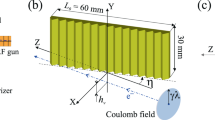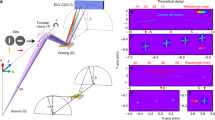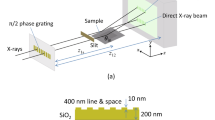Abstract
Ultrahigh-reflectance mirrors are essential optical elements of the most sophisticated optical instruments devised over the entire frequency spectrum. In the X-ray regime, super-polished mirrors with close to 100% reflectivity are routinely used at grazing angles of incidence. However, at large angles of incidence, and particularly at normal incidence, such high reflectivity has not yet been achieved. Here, we demonstrate by direct measurements that synthetic, nearly defect-free diamond crystals reflect more than 99% of hard X-ray photons backwards in Bragg diffraction, with a remarkably small variation in magnitude across the sample. This is a quantum leap in the largest reflectivity measured to date, which is at the limit of what is theoretically possible. This accomplishment is achieved under the most challenging conditions of normal incidence and with extremely hard X-ray photons.
This is a preview of subscription content, access via your institution
Access options
Subscribe to this journal
Receive 12 print issues and online access
$209.00 per year
only $17.42 per issue
Buy this article
- Purchase on Springer Link
- Instant access to full article PDF
Prices may be subject to local taxes which are calculated during checkout




Similar content being viewed by others
References
Kim, K-J., Shvyd'ko, Yu. & Reiche, S. A proposal for an X-ray free-electron laser oscillator with an energy-recovery linac. Phys. Rev. Lett. 100, 244802 (2008).
Emma, P. et al. First lasing and operation of an angstrom-wavelength free-electron laser. Nature Photon. 4, 641–647 (2010).
Kim, K-J. & Shvyd'ko, Yu. V. Tunable optical cavity for an X-ray free-electron-laser oscillator. Phys. Rev. ST Accel. Beams 12, 030703 (2009).
Lindberg, R. R., Kim, K-J., Shvyd'ko, Yu.V. & Fawley, W. M. Performance of the X-ray free-electron laser oscillator with crystal cavity. Phys. Rev. ST Accel. Beams 14, 0110701 (2011).
Altarelli, M. et al. XFEL: The European X-Ray Free-Electron Laser: Technical Design Report (DESY, 2006).
Als-Nielsen, J. & Freund, A. K. Diamond single crystals as X-ray monochromator for synchrotron radiation. ESRF Newsletters 13, 4 (1992).
Khounsary, A. M., Smither, R. K., Davey, S. & Purohit, A. Diamond monochromator for high heat flux synchrotron X-ray beams. Proc. SPIE 1739, 628–642 (1992).
Berman, L. E. et al. Diamond crystal X-ray optics for high-power-density synchrotron radiation beams. Nucl. Instrum. Methods Phys. Res. A 329, 555–563 (1993).
Freund, A. K. Diamond single crystals: the ultimate monochromator material for high-power X-ray beams. Opt. Eng. 34, 432–440 (1995).
Fernandez, P. et al. Test of a high-heat-load double-crystal diamond monochromator at the advanced photon source. Nucl. Instrum. Methods Phys. Res. A 400, 476–483 (1997).
Sellschop, J. P. F. et al. Synchrotron X-ray applications of synthetic diamonds. New Diamond and Frontier Carbon Technol. 10, 253–258 (2000).
Sumiya, H., Toda, N. & Satoh, S. High-quality large diamond crystals. New Diamond and Frontier Carbon Technol. 10, 233–251 (2000).
Yabashi, M. et al. Diamond double-crystal monochromator for spring-8 undulator beamlines. AIP Conf. Proc. 879, 922–925 (2007).
Burns, R. C. et al. HPHT growth and X-ray characterization of high-quality type IIa diamond. J. Phys. Condens. Matter 21, 364224 (2009).
Shvyd'ko, Yu. V., Stoupin, S., Cunsolo, A., Said, A. & Huang, X. High-reflectivity high-resolution X-ray crystal optics with diamonds. Nature Phys. 6, 196–199 (2010).
Prelas, M. A., Popovici, G. & Bigelow, L. K. (eds) Handbook of Industrial Diamonds and Diamond Films (Marcel Dekker, 1998).
Stoupin, S. & Shvyd'ko, Yu. V. Thermal expansion of diamond at low temperatures. Phys. Rev. Lett. 104, 085901 (2010).
Stoupin, S. & Shvyd'ko, Yu. V. Ultraprecise studies of the thermal expansion coefficient of diamond using backscattering X-ray diffraction. Phys. Rev. B 83, 104102 (2011).
Authier, A. Dynamical Theory of X-Ray Diffraction, IUCr Monographs on Crystallography Vol. 11 (Oxford Univ. Press, 2001).
Shvyd'ko, Yu. X-Ray Optics—High-Energy-Resolution Applications, Optical Sciences Vol. 98 (Springer, 2004).
Afanas'ev, A. M. & Perstnev, I. P. On the Bragg reflexion from ideal absorbing crystals. Acta Crystallogr. A25, 520–523 (1969).
Toellner, T. S., Alatas, A. & Said, A. H. Six-reflection meV-monochromator for synchrotron radiation. J. Synchrotron Radiat. 18, 605–611 (2011).
Stoupin, S. et al. Hard X-ray monochromator with meV bandwidth for high-resolution diffraction studies of diamond crystals. Rev. Sci. Instrum. (submitted).
Acknowledgements
The authors are grateful to Kwang-Je Kim (APS) for stimulating interest and discussions. We are indebted to V. Denisov, S. Polyakov and M. Kuznezov (TISNCM) for help in growing and characterizing the diamond crystals. D. Shu (APS) is acknowledged for the development of the 13.9 keV high-resolution X-ray monochromator crucial for the present studies. A.H. Said and D. Walko (APS) are acknowledged for the beamline support. Thanks go to X. Huang (APS), B. Raghothamachar and M. Dudley (SUNY) for supporting the white beam topography studies at beamline X19C of the National Synchrotron Light Source. The authors are indebted to R. Lindberg (APS) for reading the manuscript and providing valuable suggestions. Work was supported by the US Department of Energy (DoE), Office of Science, Office of Basic Energy Sciences (contract no. DE-AC02-06CH11357). Use of the National Synchrotron Light Source, Brookhaven National Laboratory, was supported by the DoE (contract no. DE-AC02-98CH10886). This work is dedicated to the memory of Uwe van Bürck.
Author information
Authors and Affiliations
Contributions
Y.S. planned, organized, and performed the experiments, analysed the data and wrote the paper. S.S. built the 13.9 keV high-resolution monochromator, and performed reflectivity experiments and white beam topography studies of diamonds. V.B. and S.T. organized the manufacture of synthetic diamonds, and synthesized, processed and characterized the diamond crystals.
Corresponding author
Ethics declarations
Competing interests
The authors declare no competing financial interests.
Supplementary information
Supplementary information
Supplementary information (PDF 959 kb)
Rights and permissions
About this article
Cite this article
Shvyd'ko, Y., Stoupin, S., Blank, V. et al. Near-100% Bragg reflectivity of X-rays. Nature Photon 5, 539–542 (2011). https://doi.org/10.1038/nphoton.2011.197
Received:
Accepted:
Published:
Issue Date:
DOI: https://doi.org/10.1038/nphoton.2011.197
This article is cited by
-
Towards Room Temperature Thermochromic Coatings with controllable NIR-IR modulation for solar heat management & smart windows applications
Scientific Reports (2024)
-
Free-electron interactions with van der Waals heterostructures: a source of focused X-ray radiation
Light: Science & Applications (2023)
-
Low-loss stable storage of 1.2 Å X-ray pulses in a 14 m Bragg cavity
Nature Photonics (2023)
-
The MING proposal at SHINE: megahertz cavity enhanced X-ray generation
Nuclear Science and Techniques (2023)
-
Usage of electron back scattering diffraction for investigation of buried damage layer underneath a single crystalline diamond surface
Journal of Materials Science: Materials in Electronics (2017)



